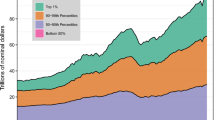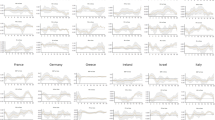Abstract
This study investigates the effects of the wealth and credit channels of monetary transmission mechanisms on consumer durables spending and housing investment. A New Keynesian Dynamic Stochastic General Equilibrium model that incorporates financial frictions is used to derive impulse response functions. The results indicate strong evidence for an amplifying effect of financial frictions on aggregate economic activity. Output, spending on consumer durable goods, housing investment, housing prices, and household wealth respond positively and significantly to a 50-basis point cut in the federal funds rate. The wealth channel is only found to have marginal effects upon household spending.






Similar content being viewed by others
Notes
Therefore, 1−π(ϖ) will be the expected gross share of profits for the home-owner or the borrower.
The details of aggregation across a continuum of durable goods are given in Appendix B.
VAR and DSGE results in BGG, Bernanke and Gertler [1995] show similar effects of real variables for a monetary policy shock.
References
Aoki, Kosuke, James Proudman, and Gertjan Vlieghe. 2004. House Prices, Consumption, and Monetary Policy: A Financial Accelerator Approach. Journal of Financial Intermediation, 13(4): 414–435.
Bernanke, Ben, and Mark Gertler. 1995. Inside the Black Box: The Credit Channel of Monetary Policy Transmission. The Journal of Economic Perspectives, 9(4): 27–48.
Bernanke, Ben S., Mark Gertler, and Simon Gilchrist. 1999. The Financial Accelerator in a Quantitative Business Cycle Framework, in Handbook of Macroeconomics, edited by John B. Taylor and Michael Woodford North Holland, Vol. 1, Part 3, 1341–1393.
Calvo, G. 1983. Staggered Prices in a Utility-Maximizing Framework. Journal of Monetary Economics, 12: 383–398.
Carlstrom, C., and T. Fuerst. 1997. Agency Costs, Net Worth, and Business Fluctuations: A Computable General Equilibrium Analysis. American Economic Review, 87(5): 893–910.
Clarida, Richard, Jordi Gali, and Mark Gertler. 1999. The Science of Monetary Policy: A New Keynesian Perspective. Journal of Economic Literature, XXXVII(4): 1661–1707.
De Bondt, G.J. 1999. Credit Channels and Consumption: European Evidence. DNB Staff Reports No. 39. Amsterdam, the Netherlands: De Nederlandsche Bank.
Goodfriend, Marvin, and Robert King. 1997. The New Neoclassical Synthesis and the Role of Monetary Policy. The Federal Reserve Bank of Richmond, Working Paper Series 98-05. Richmond, Virginia.
Iacoviello, Matteo. 2005. House Prices, Borrowing Constraints, and Monetary Policy in the Business Cycle. American Economic Review, 95(3): 739, 764.
Iacoviello, Matteo, and Stefano Neri. 2010. Housing Market Spillovers: Evidence from an Estimated DSGE Model. American Economic Journal: Macroeconomics, 2(2): 125–164.
Ireland, Peter. 2005. The Monetary Transmission Mechanism. Working Paper No 06-1, Boston, MA: Federal Reserve Bank of Boston.
Kiyotaki, N., and J. Moore. 1997. Credit Cycles. Journal of Political Economy, 105(2): 211–248.
Kuttner, Kenneth, and Ptricia C. Mosser. 2002. The Monetary Transmission Mechanism: Some Answers and Further Questions. Economic Policy Review. Federal Reserve Bank of New York.
Ludvigson, Sydney, Charles Steindel, and Martin Lettau. 2002. Monetary Policy Transmission Through the Consumption Wealth Channel. Economic Policy Review. New York: Federal Reserve Bank of New York, 117–133.
McCallum, B, and E. Nelson. 1999. Performance of Operational Policy Rules in an Estimated Semi Classical Structural Model, in Monetary Policy Rules, edited by J. Taylor Chicago, IL: University of Chicago press.
Monacelli, Tomasso. 2008. Optimal monetary policy with collateralized household debt and borrowing constraints. in Asset Prices and Monetary Policy, edited by John Y. Campbell. NBER Chapters, Chicago, IL:The University of Chicago Press, 103–146.
Rotemberg, Julio J., and Michael Woodford. 1999. Interest Rate Rules in an Estimated Sticky Price Model, NBER Chapters in Monetary Policy Rules, edited by John B. Taylor National Bureau of Economic Research: Chicago: The University of Chicago Press, 57–126.
Taylor, B. John. 1993. Discretion Versus Policy Rules in Practice. Carnegie-Rochester Conference Series on Public Policy, Vol. 39, pp. 195–214.
Taylor, B. John. 1995. The Monetary Transmissions Mechanism: An Empirical Framework. Journal of Economic Perspectives, 9(4): 11–26.
Valcarcel, Victor. 2013. The Impact of Government Spending on Private Spending in a Two-Sector Economy. Public Finance Review, 41(2): 248–272.
Woodford, M. 1996. Control of Public Debt: A Requirement for Price Stability? NBER Working Paper Series, No. 5684.
Acknowledgements
The author is grateful for the suggestions received from the participants of the 82nd Annual Meeting of the Southern Economic Association in New Orleans, LA and the 49th Annual Meeting of the Missouri Valley Economic Association in Memphis, TN. The author would also like to thank the editors Edward Gamber and Allan A. Zebedee, one anonymous referee, Professors Max Cherem and Patrik Hultberg for their comments, which substantially improved the paper.
Author information
Authors and Affiliations
Corresponding author
Appendices
APPENDIX A
General equilibrium
Aggregate demand







Aggregate supply




Evolution of state variables


Monetary policy and shock processes

Where the nominal and real interest rates are related by




Definition of parameters




Description of the log-linearized equations
The first equation in the aggregate demand block is the aggregate resource constraint. The second and third equations are consumption Euler equations for Home owners and consumers and they are log-linearized versions of (6) and (11). equation (A.4) is the key element of this model. It describes the external finance premium (the difference between the return on housing and the risk-free rate) as a function of household net worth, house price, and the stock of housing. In the ideal case of no financial frictions, this equation reduces to  , that is, the expected return on housing is equal to the risk-free rate. Under this scenario the partial equilibrium for home purchase decision implies that there will be an infinite amount of purchase if
, that is, the expected return on housing is equal to the risk-free rate. Under this scenario the partial equilibrium for home purchase decision implies that there will be an infinite amount of purchase if  while on the other hand there will be no home purchase if
while on the other hand there will be no home purchase if  . This equation is the log-linearized version of equation (2). The next equations (A.5) and (A.6) are log-linearized representations of equations (19) and (20) describing the return on housing and housing investment, respectively.
. This equation is the log-linearized version of equation (2). The next equations (A.5) and (A.6) are log-linearized representations of equations (19) and (20) describing the return on housing and housing investment, respectively.
The set of equations (A.7), (A.8), (A.9) through (A.10) describe the aggregate supply block of the general equilibrium model. Equation (A.7) is the log-linearized version of the production function (18), which assumes the supply of home owner’s labor is fixed. Equation (A.8) is the marginal cost for a firm and is the log-linear representation of equation (25). Equation (A.8) together with equation (A.9) characterize labor market equilibrium. Equation (A.10) is a form of the new Keynesian Philips curve describing the relationship between current inflation, future expected inflation and firm’s marginal cost of production.
The next block of equations (A.11) and (A.12) describe the evolution of state variables housing and net worth, respectively. equation (A.11) is the standard log-linearized version of equation (16). Home owner’s net worth evolves and is determined by their equity holdings, labor income and dividends collected from firms.
The final block of the system of equations (A.13), (A.14), (A.15), (A.16) and (A.17) lists monetary policy and the three exogenous processes and shocks in the model, that is, demand, supply, and wealth shocks. Monetary policy, in the interest of capturing the variation in the short-term interest rate and following Clarida et al. [1999] is formulated as the nominal interest rate at time period t adjusting to changes in lagged inflation and interest rate.
APPENDIX B
Aggregation across durable consumption goods
Aggregate consumption is given by the following expression:

The aggregation across a continuum of durable consumption goods in the interval [0,1] is represented by the Dixit-Stiglitz aggregator of the form:

In which case c t (i) represents the quantity of good i consumed by the household in period t. Taking into account that ɛ>1, the corresponding price index for consumption goods for all iє[0, 1] is given by:

Where P ct (i) is the price of durable consumer good i and P ct is the composite price for the number of goods indexed by [0, 1].
Households have to decide how to allocate consumption expenditures among different goods, which requires the consumption index c
t
to be maximized for any given level of expenditures  . The solution to this problem yields the set of demand equations:
. The solution to this problem yields the set of demand equations:

Home owners also need to optimally make decisions regarding their portfolio allocations between consumption of durable goods and housing services. This decision, among other things, depends on the relative prices of housing and consumption goods. The composite price for aggregate consumption P t is formulated as:

Where P
ct
and P
ht
represent prices for consumer durables and the rental price of houses, respectively. Consumers maximize aggregate consumption  subject to expenditures upon these goods, yielding the following demand functions for durable goods c
t
and housing services h
t
subject to expenditures upon these goods, yielding the following demand functions for durable goods c
t
and housing services h
t


Rights and permissions
About this article
Cite this article
Geremew, M. How the Wealth and Credit Channels in Monetary Transmission Affect Consumer Durables and Housing: A Dynamic Stochastic General Equilibrium Approach. Eastern Econ J 43, 406–425 (2017). https://doi.org/10.1057/eej.2016.10
Published:
Issue Date:
DOI: https://doi.org/10.1057/eej.2016.10




